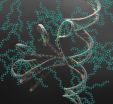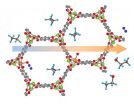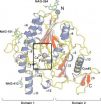(Press-News.org) Crowding has notoriously negative effects at large size scales, blamed for everything from human disease and depression to community resource shortages. But relatively little is known about the influence of crowding at the cellular level. A new JILA study shows that a crowded environment has dramatic effects on individual biomolecules.
In the first data on the underlying dynamics (or kinetics)of crowded single biomolecules , reported in Proceedings of the National Academy of Sciences,* JILA researchers found that crowding leads to a 35-fold increase in the folding rate of RNA (ribonucleic acid), while the unfolding rate remains relatively stable.
RNA is a long chain-like molecule that contains genetic information, makes proteins and catalyzes biological reactions. It must fold into the correct 3D shape to function properly. The new results show that while RNA usually spends most of its time unfolded, in a crowded situation it folds much more often, although it remains folded for the usual period of time during each round.
"Cells are 25 to 35 percent filled with 'stuff'—proteins, nucleic acids, lipids, etc.—and the effect of crowding on simple reactions like folding of nucleic acids and proteins is not well understood," JILA/NIST Fellow David Nesbitt says. "Almost all detailed kinetic data comes from in vitro studies, that is, not in a living cell.
"But our work at the single-molecule level suggests that the rates and equilibrium constants (where folding and unfolding rates are equal) for simple nucleic acid folding processes may be shifted by up to 400,000 percent or more from what one might expect from such uncrowded solution studies."
Nesbitt's group used a specialized microscope to study RNA folding over time in solutions containing various concentrations of a large common polymer, PEG.** The size of the PEG molecule constrains the 3D space around the RNA, mimicking the contents of crowded cells better than the typical dilute solutions used in test-tube studies.
Although PEG was previously known to encourage the compactor folded states of biomolecules, the JILA results are the first to determine the underlying processes. The results were not obvious, in that crowding might seem likely to suppress RNA unfolding. JILA researchers suggest that instead, the opposite process is at work: Crowding lowers the energy required for RNA to achieve the transition state for folding, making it easier to fold.
The JILA study also analyzed temperature-related data to show that the boost in the RNA folding rate constant is largely due to the disorder (or entropy) of the mixture, rather than simply the tendency for RNA to stabilize in the shape with the lowest energy.
In addition to collecting experimental data, JILA researchers used a simple particle model to estimate what would happen in the extremely crowded environment of the cell. The results suggest that the RNA folding equilibrium constant could potentially increase more than 4,000-fold—resulting in a dramatically different biochemical composition—while the folding rate could increase more than 1,000-fold. JILA researchers speculate that such extreme effects could profoundly influence both the rates and preferred directions of complex biochemical pathways in cells. Further studies are needed to determine whether the model can be extended to other cell contents and other RNA structures.
INFORMATION:
The research was funded by the National Science Foundation and NIST.
*N.F. Dupuis, E.D. Holmstrom and D.J. Nesbitt. Molecular crowding effects on single molecule RNA folding/unfolding thermodynamics and kinetics. Proceedings of the National Academy of Sciences. Published online in Early Edition, May 21, 2014. doi:10.1073/pnas.1316039111
**Specifically, hmwPEG: high molecular weight polyethyleneglycol.
JILA study finds crowding has big effects on biomolecules
2014-05-22
ELSE PRESS RELEASES FROM THIS DATE:
From separation to transformation: Metal-organic framework shows new talent
2014-05-22
This gift from science just keeps on giving. Measurements taken at the National Institute of Standards and Technology (NIST) show why a material already known to be good at separating components of natural gas also can do something trickier: help convert one chemical to another, a process called catalysis. The discovery is a rare example of a laboratory-made material easily performing a task that biology usually requires a complex series of steps to accomplish.
The material is a metal-organic framework (MOF), one of a class of substances whose porosity, high surface area ...
Don't blink! NIST studies why quantum dots suffer from 'fluorescence intermittency'
2014-05-22
Researchers at the National Institute of Standards and Technology (NIST), working in collaboration with the Naval Research Laboratory, have found that a particular species of quantum dots that weren't commonly thought to blink, do.
So what? Well, although the blinks are short—on the order of nanoseconds to milliseconds—even brief fluctuations can result in efficiency losses that could cause trouble for using quantum dots to generate photons that move information around inside a quantum computer or between nodes of a future high-security internet based on quantum telecommunications.
Beyond ...
Putting a number on opinion dynamics in a population
2014-05-22
Philadelphia, PA—Opinion formation in a large population is influenced by both endogenous factors, such as interaction with one's peers—in-person and via social media—as well as exogenous factors, such as the media, of which mainstream media is one of the most influential factors. For example, according to a study conducted by the National Bureau of Economic Research in 2006, after the introduction and expansion of Fox News in the United States between 1996 and 2000, an estimated 3-28% of the audience was persuaded to vote Republican.
In a recent paper published in ...
NIST chip produces and detects specialized gas for biomedical analysis
2014-05-22
A chip-scale device that both produces and detects a specialized gas used in biomedical analysis and medical imaging has been built and demonstrated at the National Institute of Standards and Technology (NIST). Described in Nature Communications,* the new microfluidic chip produces polarized (or magnetized) xenon gas and then detects even the faintest magnetic signals from the gas.
Polarized xenon—with the atoms' nuclear "spins" aligned like bar magnets in the same direction—can be dissolved in liquids and used to detect the presence of certain molecules. A chemical interaction ...
NCNR neutrons highlight possible battery candidate
2014-05-22
Analysis of a manganese-based crystal by scientists at the National Institute of Standards and Technology (NIST) and the Massachusetts Institute of Technology (MIT) has produced the first clear picture of its molecular structure. The findings could help explain the magnetic and electronic behavior of the whole family of crystals, many of which have potential for use in batteries.
The family of crystals it belongs to has no formal name, but it has three branches, each of which is built around manganese, cobalt or iron—transition metals that can have different magnetic ...
Bending helps to control nanomaterials
2014-05-22
A new remedy has been found to tackle the difficulty of controlling layered nanomaterials. Control can be improved by simply bending the material.
The mechanism was observed by Academy Research Fellow Pekka Koskinen from the Nanoscience Center of the University of Jyväskylä together with his colleagues from the University of Massachusetts Amherst in the US. Bending decreases interaction between layers, making the material merely a stack of independent atomic layers.
The group investigated the van der Waals nanomaterials which consist of stacked and loosely bound two-dimensional ...
Safety in numbers: Moderate drinking in a group reduces attraction to risk
2014-05-22
New research led by the University of Kent shows that individuals who have consumed moderate amounts of alcohol in social situations are likely to view risky situations with greater caution when considering them as part of a group.
The research, by psychologists from the University of Kent and the University of East Anglia, produced the first evidence found outside of laboratory conditions that being in a group can reduce some effects of alcohol consumption. The findings could lead to the design of new interventions designed to promote safer recreational drinking.
Researchers ...
Scientists provide insight into the pathology of Sanfilippo A syndrome
2014-05-22
Sanfilippo A syndrome or Mucopolysaccharidosis IIIA (MPS-IIIA) is a rare genetic lysosomal storage disease inherited from the parents of the patient. Lysosomes are the body's vehicle for breaking down many of its by-products such as proteins, nucleic acids, carbohydrates, lipids and cellular debris. The spherical vesicles are known to contain 50 different enzymes which are all active around an acidic environment of about pH 5.
Whilst each lysosomal disorder results from different gene mutations that translate into a deficiency in enzyme activity, they all share a common ...
Marriage of convenience with a fungus
2014-05-22
This news release is available in German. Thanks to a fungus, the medicinal plant ribwort plantain gains a higher concentration of the defensive compound catalpol. Biologists at Bielefeld University report this discovery in a study to be published this Thursday (22.5.2014) in the scientific journal 'Nature Communications'. The increase in catalpol gives the plant better protection against pests. In the study, the research team worked with arbuscular mycorrhizal fungi. These are known to colonize the roots of land plants. The plants benefit from this, because the fungus ...
Stem-cell research: A new genetic switching element
2014-05-22
Slight modifications in their genome sequences play a crucial role in the conversion of pluripotent stem cells into various differentiated cell types. A team at Ludwig-Maximilians-Universitaet (LMU) in Munich has now identified the factor responsible for one class of modification.
Every cell contains stored hereditary information, encoded in the sequence of nucleobases that make up its DNA. However, in any given cell type, only a fraction of this information is actually used. Which genes are activated and which are turned off is in part determined by a second tier of ...





